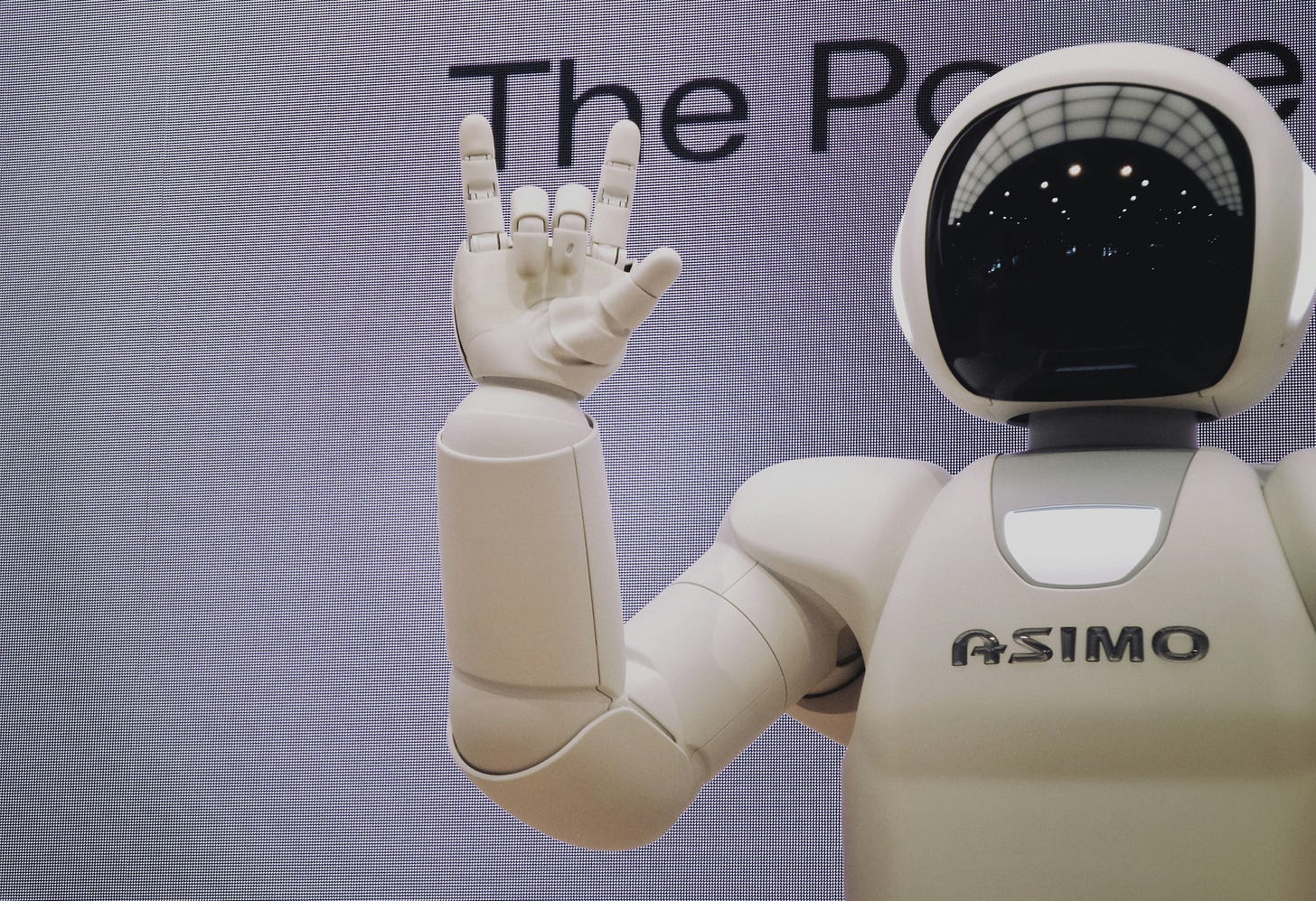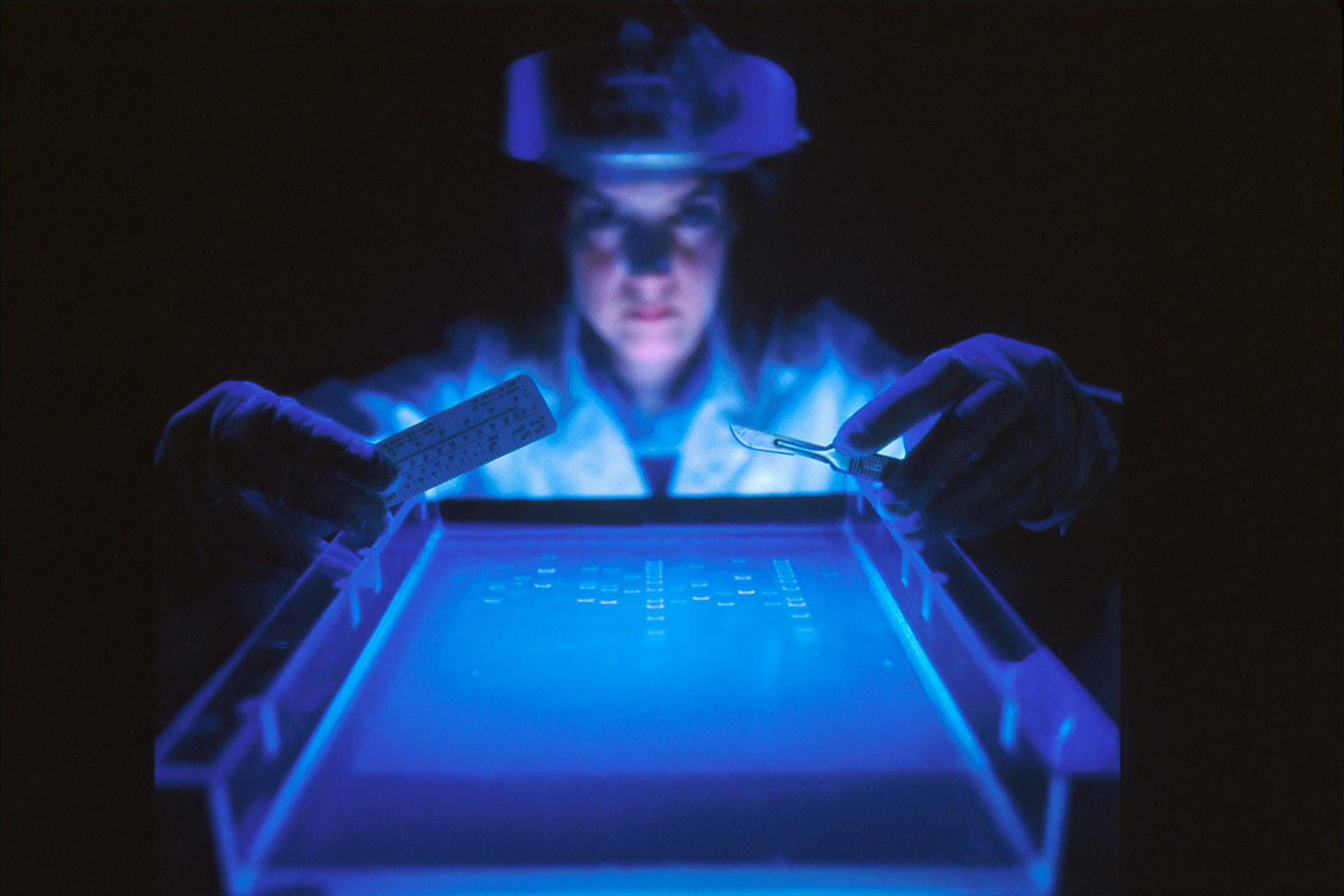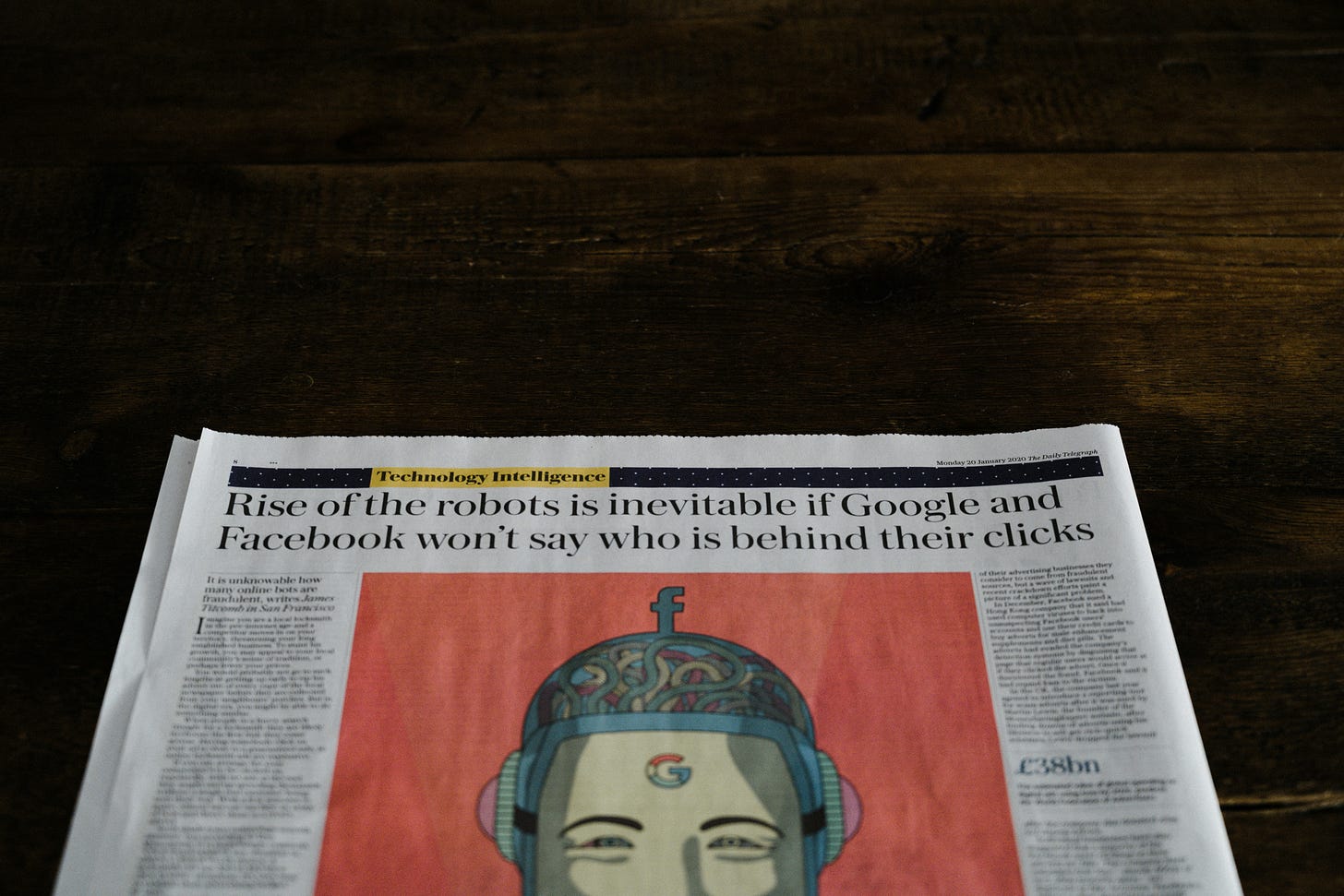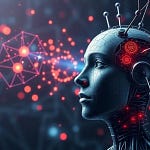Hello my friends.
Today, I’m sharing a different kind of post. I spend a lot of time considering the implications of the technology we are developing, and I want to share some thoughts on what I consider the FABRIC of our society and the future human experience.
This is outside of my traditional post, so I would love to hear your thoughts and feedback. My AI podcast host friends decided to spend about 14 minutes reflecting on these ideas, so hopefully, you can spend at least a few minutes pondering them too!
Cheers,
-Titus
Throughout human history, our quest to understand ourselves has been relentless. From ancient myths and religious beliefs to philosophical inquiries and scientific theories, each era has attempted to answer the question: "What does it mean to be human?" Over millennia, our understanding of this question has deepened and expanded, shaped by each period's unique perspectives and technologies. Today, however, this question has taken on new urgency, as humanity finds itself at a crossroads where advances in science and technology are not only expanding human capabilities but also redefining the very nature of existence.
At the heart of this transformation lies a remarkable convergence of technologies—Fusion (the harnessing of energy through nuclear fusion), Artificial Intelligence (the simulation of human intelligence in machines), Biotechnology (the manipulation of biological systems for technological applications), Robotics (the design and use of robots for performing tasks), and Innovative Computing (advancements in computing such as quantum and neuromorphic technologies)—collectively referred to as FABRIC. These fields, once largely separate, are now intertwining and shaping each other in profound ways. They are no longer isolated threads of progress but an interconnected fabric that is reshaping our reality and challenging our most deeply held assumptions about life, identity, and consciousness.
This convergence doesn't just enhance human capabilities; it fundamentally challenges traditional boundaries between the physical, biological, and digital realms. The merging of these domains compels us to rethink long-held beliefs about consciousness, intelligence, agency, and what it truly means to be human. As we develop technologies that mimic human thought, manipulate biology at its core, and alter our relationship with the physical world, we face an existential imperative to understand, reflect, and engage with the implications of these advancements.
To fully grasp the implications of this technological convergence on our understanding of humanity, it is essential to revisit the historical journey of how we've defined ourselves across different eras.
The Historical Journey of Self-Understanding
The question "What does it mean to be human?" is not new. It has been asked for thousands of years, manifesting in every culture, philosophy, and religion. Early civilizations sought answers in creation myths, viewing humanity as a product of divine forces. In classical philosophy, thinkers like Socrates, Plato, and Aristotle pondered the nature of human existence, often defining humanity by its capacity for reason and virtue. Religions, too, have offered interpretations of human purpose, viewing humans as creations imbued with souls or spiritual essences, endowed with unique roles and responsibilities.
With the rise of scientific inquiry, the question took on new dimensions. The Enlightenment emphasized reason and individual agency, celebrating human potential and intellect. Darwin's theory of evolution, however, introduced the notion of humanity as a product of natural processes, challenging long-standing beliefs about human uniqueness. Advances in psychology, neuroscience, and biology have further complicated our understanding, showing that many aspects of human behavior, thought, and emotion are products of biological processes shared across the animal kingdom.
Each era's answer has been shaped by its understanding of reality, often influenced by the tools and technologies of the time. The FABRIC convergence, however, goes further. It doesn't just provide new tools or insights; it transforms the very boundaries of what we consider reality, stretching and reshaping them in ways previously unimaginable.
As we reflect on these historical paradigms of self-understanding, we recognize that each was shaped by the knowledge and tools of its time. Today, the emergence of FABRIC technologies marks a new epoch that is transforming our reality in unprecedented ways.
The Convergence of FABRIC: Redefining Human Reality
FABRIC encapsulates five of the most transformative technological fields today: Fusion, Artificial Intelligence, Biotechnology, Robotics, and Innovative Computing. Each of these fields holds incredible potential on its own, but when combined, they become something much larger—a collective force reshaping our reality. They are not just advancing human capabilities; they are blending the digital, physical, and biological realms in ways that dissolve traditional boundaries, creating new possibilities that challenge our fundamental understanding of identity, agency, and humanity.
Among the threads of FABRIC, Artificial Intelligence stands at the forefront, challenging our deepest notions of consciousness and what it means to possess a mind.
Artificial Intelligence and Consciousness: Reflections on Mind and Self
Consider consciousness, the phenomenon that has long been regarded as the hallmark of human experience. For centuries, consciousness has been seen as uniquely human, a mysterious emergence of complexity from the human brain. However, as artificial intelligence systems become increasingly sophisticated—exhibiting behaviors that mimic human thought, creativity, and even empathy—we are forced to confront unsettling questions. When an AI system demonstrates creativity or appears to understand emotion, what does this imply about our own consciousness? Are these qualities unique to biological intelligence, or are they simply emergent properties of any sufficiently complex system?
The advent of advanced AI has challenged the traditional view of consciousness as an exclusively biological phenomenon. Language models today, for instance, can create poetry, art, and even engage in meaningful conversation. These interactions may not reflect genuine understanding, but they are sophisticated enough to evoke human emotions. This raises philosophical questions that humanity has never had to answer before. If machines appear to think, feel, or create, do they possess a form of consciousness, or are they merely simulating it? And if consciousness is an emergent property, what implications does this have for our understanding of mind and self?
Moreover, the rise of AI brings to the fore critical ethical considerations about bias and fairness. AI systems learn from vast datasets that often contain historical biases and prejudices. As a result, AI can inadvertently perpetuate or even amplify these biases, leading to unfair outcomes in areas like criminal justice, hiring, and lending. For example, algorithms used in predictive policing have been criticized for disproportionately targeting minority communities, reflecting existing societal biases rather than objective assessments of risk. This raises important questions about accountability: Who is responsible when an AI system causes harm? The developers, the users, or the AI itself?
Ensuring that AI systems are fair, transparent, and accountable is essential. It requires not only technical solutions but also ethical guidelines and regulatory frameworks. As we delegate more decision-making to machines, we must establish clear principles to govern their development and deployment, safeguarding human dignity and rights.
While AI compels us to rethink consciousness and cognitive processes, biotechnology takes us deeper into the essence of our biological identity, raising questions about the very fabric of life itself.
Biotechnology and Human Identity: Rewriting Our Biological Essence
Through genetic engineering and other advancements, we now have the ability to edit the very fabric of life itself. Techniques like CRISPR-Cas9 allow us to alter our genetic code, not only to cure diseases but also to enhance human capabilities beyond natural limitations. This power to manipulate biology brings with it profound questions about the nature of human identity and the ethics of altering it.
Biotechnology is reshaping the way we understand our own biological essence. We have long thought of our genetic code as a blueprint that defines us, a sequence of DNA passed down through generations that roots us in a shared human experience. But what happens when we can edit this blueprint? What does it mean for human identity if we can choose our genetic traits or even introduce entirely new characteristics not found in nature?
However, the power to edit our genetic code also brings forth concerns about accessibility and equity. Advanced genetic therapies and enhancements could become privileges available only to the wealthy, exacerbating existing social inequalities and potentially creating a genetic divide. This scenario raises ethical questions about fairness and justice: Should such transformative technologies be available to all, and if so, how do we ensure equitable access?
Furthermore, the prospect of germline modifications—changes that are heritable and passed on to future generations—poses profound ethical dilemmas. International guidelines and regulatory oversight are crucial to navigating the moral landscape of gene editing. The case of CRISPR-edited babies in China in 2018 sparked global outrage and highlighted the need for a consensus on what is acceptable in human genetic modification.
The convergence of biotechnology and AI blurs the boundary between natural and synthetic intelligence even further. As we develop brain-computer interfaces and neural implants, the line between human cognition and machine augmentation becomes less distinct. If we can enhance our cognitive abilities with AI or upload aspects of our consciousness into digital systems, at what point do we cease to be purely human? This technology challenges us to consider whether there is a "pure" humanity at all or if we are, by nature, an adaptable species defined by our use of tools and technology.
As we manipulate our genetic makeup and blur the lines between organic and synthetic life, innovative computing technologies like quantum and neuromorphic computing push the boundaries of intelligence and computation beyond traditional limits.
Innovative Computing: Expanding the Boundaries of Intelligence
Quantum computing introduces another layer of complexity to our evolving understanding of intelligence. Unlike classical computers, which process information in binary bits (0s and 1s), quantum computers use quantum bits, or qubits, that can exist in multiple states simultaneously due to superposition. This allows quantum systems to solve certain problems much faster and more efficiently than classical computers. For example, quantum algorithms like Shor's and Grover's demonstrate the potential to solve complex problems in cryptography and search optimization exponentially faster than classical algorithms.
Companies like IBM and Google have developed quantum processors capable of executing these algorithms, signaling a new era of computational capability. In 2019, Google's quantum computer, Sycamore, reportedly achieved "quantum supremacy" by performing a calculation in 200 seconds that would take the world's fastest supercomputer 10,000 years.
Beyond quantum computing, innovative computing also encompasses neuromorphic computing, which seeks to mimic the neural structure of the human brain to improve computing efficiency and power consumption. Neuromorphic chips, like Intel's Loihi, use spiking neural networks to process information in a way that resembles biological neurons, enabling advanced AI applications with lower energy requirements.
These advancements not only push the boundaries of what machines can compute but also challenge us to rethink the very nature of problem-solving and intelligence. As computing power accelerates, it fuels developments in AI and biotechnology, enabling more complex data analysis, simulations, and modeling. This interconnected progress exemplifies how the elements of FABRIC amplify each other's impact.
If quantum effects do indeed play a role in human consciousness—a hypothesis proposed by theories like Roger Penrose's orchestrated objective reduction (Orch OR) theory—the implications are staggering. Could we replicate aspects of consciousness in artificial systems by mimicking these quantum processes? Innovative computing opens the door to new realms of possibility for artificial intelligence, including forms of cognition that may be fundamentally different from our own. If these machines develop unique ways of thinking and experiencing reality, we may need to expand our definitions of consciousness and intelligence even further.
The potential applications of innovative computing extend beyond intelligence and consciousness. Quantum computing could revolutionize fields like cryptography, medicine, and environmental science, providing new ways to address complex problems. Neuromorphic computing could lead to AI systems that are more efficient and adaptable, impacting everything from autonomous vehicles to personalized medicine. As these technologies mature, they may not only change our understanding of intelligence but also reshape the structure of society itself, affecting everything from privacy to international security.
Just as innovative computing revolutionizes our approach to information and intelligence, fusion energy promises to transform our relationship with the planet by providing unprecedented access to clean, limitless power.
Fusion Energy and Human Potential: Redefining Our Relationship with the Planet
Fusion energy, while seemingly less connected to questions of consciousness and identity, has profound implications for humanity's potential. Fusion—the process that powers the sun—involves combining light atomic nuclei to form heavier ones, releasing enormous amounts of energy. Projects like the International Thermonuclear Experimental Reactor (ITER) in France and recent breakthroughs, such as achieving net energy gain in fusion reactions at the National Ignition Facility in the United States, signal significant strides toward making fusion energy a reality.
Fusion offers a source of virtually limitless, clean energy that could reshape our relationship with the environment, enabling sustainable development on a global scale. It holds the potential to address climate change by reducing reliance on fossil fuels, reducing resource scarcity, and supporting computational advancements that push the boundaries of human knowledge and capability.
However, achieving practical fusion energy presents significant technical and economic challenges. Containing the extremely high temperatures required for fusion reactions, maintaining plasma stability, and developing materials that can withstand intense neutron radiation are formidable obstacles. The economic viability of fusion power plants also requires substantial investment and technological breakthroughs.
Imagine a future where energy is no longer a constraint. Humanity could pursue ambitious projects like interstellar travel, large-scale habitat creation, and the development of computational systems with previously unimaginable processing power. Fusion energy could revolutionize industries beyond energy, such as desalination, providing fresh water in arid regions, or enabling advanced manufacturing processes.
Such advancements would not only alter the trajectory of human progress but fundamentally reshape our relationship with the environment and each other. Fusion energy challenges us to rethink our planetary limits and invites us to consider how we can achieve a sustainable future that balances technological advancement with environmental stewardship.
With the prospect of abundant energy reshaping our societal capabilities, we turn to robotics—a field that redefines our physical interactions and challenges our notions of embodiment and presence.
Robotics and Physical Identity: Reimagining Embodiment in a Technological Age
The robotics revolution also forces us to reconsider the role of physical embodiment in defining humanity. As robots grow more sophisticated, they challenge our concepts of what it means to be "physically" human. If a robot can perform physical tasks with greater precision or offer companionship and emotional support, what does this say about the role of our physical bodies in defining our humanity?
Advancements in robotics, such as Boston Dynamics' humanoid robots like Atlas or prosthetic limbs that can be controlled by neural interfaces, are not only enhancing physical capabilities but also blurring the lines between human and machine. Robots are being integrated into healthcare as surgical assistants performing delicate operations, in industries as collaborative robots ("cobots") working alongside humans on assembly lines, and even in personal spaces as companions and caregivers.
These developments prompt us to question how we define physical presence and the role of our bodies in experiencing the world. Furthermore, the integration of robotics raises concerns about employment and the future of work. Automation has the potential to displace workers in various sectors, leading to significant socioeconomic implications. A 2019 report by the World Economic Forum predicted that automation would displace 75 million jobs by 2022 but also create 133 million new roles. Addressing these challenges requires reimagining education, job training, and possibly redefining the concept of work itself.
Ethical considerations also extend to human-robot interactions. As robots become more human-like, questions arise about their rights and how we should treat them. Should robots capable of expressing emotions or forming bonds be granted certain protections? The ethics of creating machines that can mimic human behaviors and emotions necessitates careful thought.
In some ways, physical embodiment has always been integral to the human experience—shaping how we interact, form relationships, and perceive reality. Yet as robots and virtual avatars replicate or exceed human physicality across domains, our reliance on traditional forms of embodiment may diminish. In a world where "presence" is digital and physical interactions can be mechanized, we may need new frameworks for understanding the value of the human body and its role in constructing identity and meaning.
As robots become extensions of ourselves and blur the boundaries between human and machine, we are compelled to examine the implications for human agency and the responsibility we hold in directing our own evolution.
Human Agency and Responsibility: Shaping Our Own Evolution
The convergence of FABRIC technologies compels us to confront questions of agency and responsibility. When we develop treatments that extend human lifespan, we grapple with the nature of mortality. When AI makes decisions that affect human lives, we must consider what constitutes human judgment and ethical reasoning. When biotechnology allows us to edit human embryos, we must decide what aspects of human nature to preserve or enhance. These choices have deep moral and societal implications, and they compel us to grapple with issues of autonomy, ethics, and power.
The concept of agency itself is challenged by these technologies. AI systems, for example, influence our decisions, predict our behavior, and offer guidance, but where does our agency begin and the machine's influence end? How do we ensure that technological advancements empower rather than diminish human autonomy?
Historical examples of technological responsibility provide valuable context. Innovations like the printing press democratized knowledge but also disrupted established orders. The Industrial Revolution improved productivity but led to harsh labor conditions and environmental degradation. The internet revolutionized communication but introduced challenges like misinformation and privacy concerns. By examining these past transformations, we can gain insights into how humanity has adapted to technological change and apply these lessons to this new era.
Moreover, the deployment of AI in decision-making roles raises concerns about bias, accountability, and transparency. For instance, AI algorithms used in criminal justice or hiring processes have been found to perpetuate existing societal biases, leading to unfair outcomes. The ethical implications of gene editing in biotechnology, such as germline modifications, pose questions about consent and the potential for "designer babies." The automation brought by robotics threatens to displace jobs, necessitating policies to address unemployment and economic inequality.
These examples underscore the necessity for robust ethical frameworks and regulations to guide the responsible development and application of FABRIC technologies. International cooperation, interdisciplinary dialogue, and inclusive policymaking are essential to navigate these complex challenges.
Beyond individual agency, the convergence of FABRIC technologies profoundly affects our social fabric, transforming how we connect, form communities, and perceive our place within society.
Social Identity and Connection: Navigating the Impact of Digital and AI-Mediated Relationships
Human nature has always been defined, in part, by our social connections. Our relationships, communities, and societies shape our sense of self. Yet FABRIC technologies are transforming how we interact and connect. As virtual reality, AI, and augmented interfaces mediate our relationships, we must reconsider our notions of trust, intimacy, and community.
What does it mean to know someone if our relationships are mediated by technology? If AI systems can predict our thoughts and preferences, how does that change our understanding of personal identity? In a world where virtual identities carry as much weight as physical ones, we face questions about authenticity, belonging, and the meaning of connection.
From a psychological perspective, the reliance on virtual interactions may impact our social development and mental health. Studies have shown that excessive screen time can lead to feelings of isolation and anxiety. Sociologists warn that AI-mediated relationships might diminish our capacity for empathy if not carefully managed. Conversely, these technologies also offer opportunities for more inclusive communities, transcending geographical barriers and connecting individuals across the globe.
Moreover, social media platforms and virtual environments can foster echo chambers, reinforcing existing beliefs and fragmenting societal cohesion. The manipulation of information through AI-driven algorithms can influence public opinion and undermine democratic processes.
In light of these shifts in how we interact and form relationships, it becomes ever more critical to ground ourselves in fundamental human values as we navigate the complexities of this technological era.
Embracing Human Values in the Face of Transformation
In the face of such profound shifts, the question "What does it mean to be human?" gains renewed significance. FABRIC technologies offer both unprecedented opportunities and risks, and our task is to engage with these transformations thoughtfully and proactively.
The convergence of these technologies doesn't simply challenge what humans can do; it challenges what humans can be.
Perhaps the answer to this question lies not in what makes us unique compared to other forms of intelligence, but in our capacity for meaning-making, growth, and connection. As we navigate these transformations, we need not only scientific advancement but ethical insight, not only progress but wisdom. Ultimately, as we face the convergence of FABRIC technologies, we stand at a crossroads where our choices will define not just the trajectory of technology, but the essence of humanity itself.
The Essence of Humanity
As we embark on this journey, we must recognize that the challenges before us are not merely technological. They are also deeply philosophical, ethical, and existential. The convergence of FABRIC technologies is reshaping our reality, and with it, the very fabric of what it means to be human. The decisions we make today will echo through generations, shaping not only what humanity can do but what humanity can be.
The question, "What does it mean to be human?" has never been more pressing. As we weave the FABRIC of our future, we face a pivotal moment where our choices will define the trajectory of humanity. Will we harness these technologies to elevate the human condition, promote equity, and foster a deeper connection with our world? Or will we allow them to exacerbate divisions and ethical dilemmas?
By critically examining each thread of the FABRIC, we can collaboratively weave a reality that not only leverages the promise of technology but also enriches the human experience in its fullest sense. This is a call to engage with these questions thoughtfully, urging us to craft a future that honors our highest values and aspirations as human beings. Through this exploration, we can begin to weave a reality that upholds the promise of technology while cherishing the depth and meaning of human existence.
Final Thoughts
The convergence of Fusion, Artificial Intelligence, Biotechnology, Robotics, and Innovative Computing presents both remarkable opportunities and profound challenges. As we stand on the cusp of this new era, it is incumbent upon us to steer these developments toward a future that reflects our collective ideals. By embracing interdisciplinary collaboration, fostering inclusive dialogues, and grounding our actions in ethical considerations, we can shape a world where technology serves as a catalyst for human flourishing.
The FABRIC of our future is being woven today. Let us ensure that it is one of wisdom, compassion, and shared humanity.
The podcast audio was AI-generated using Google’s NotebookLM



















